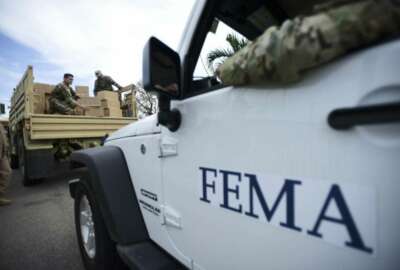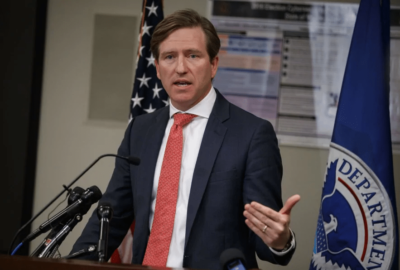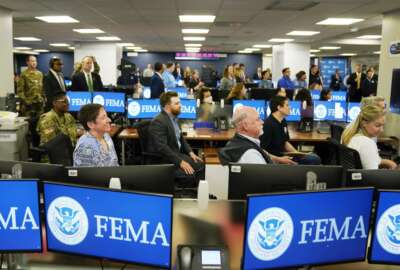New study finds FEMA disaster aid boosts entrepreneurship, increases racial disparities
For reasons that still aren't completely clear, the gap gets wider depending on how much disaster aid FEMA contributes to local relief.
Best listening experience is on Chrome, Firefox or Safari. Subscribe to Federal Drive’s daily audio interviews on Apple Podcasts or PodcastOne.
New research by sociologists at Rice University finds that when a natural disaster hits an area, self employment tends to go up. But those gains also come with inequities. Racial minorities consistently see fewer gains in entrepreneurship than white residents. And for reasons that still aren’t completely clear, the gap gets wider depending on how much disaster aid FEMA contributes to local relief programs. Asia Bento is a doctoral fellow in Rice’s sociology department, and Jim Elliot is a professor of sociology at Rice’s Kinder Institute for Urban Research. They talked to Federal Drive with Tom Temin about some of their findings.
Interview transcript:
Jared Serbu: And Jim and Asia, thanks for taking the time to do this. I appreciate it. I think the obvious place to start here is if you can just, before we get into the racial components, describe generally what we know about the reasons why self employment tends to increase in the aftermath of disasters, and how large those effects are, as far as we know?
Asia Bento: I think that’s a really good question, but one that kind of requires us to look at the motivations behind our study. And so we know that there are pre-existing inequalities in self employment, like racial disparities and inequalities in self employment, and that they are sustained by the uneven distribution of vulnerabilities and opportunities across racial groups, for those who are able to enter self employment and then maintain self employment. So if we think about access to capital, either through a bank and lending, one’s own social networks, even the savings we might have in our own bank accounts are kind of all racially distributed. And so we were curious to look at whether or not a natural disaster and then the federal aid that flows into an area, after a disaster, kind of play into exaggerating these opportunities and vulnerabilities. And so we know, right, that one’s vulnerability to disaster can be unequally distributed by race. And then recent work by my co-author and in the FEMA National Advisory Council also show that recovery opportunities are uneven. And they may make recovery worse, exaggerate inequalities. And so we look at self employment, particularly like I said before, because there are pre-existing inequalities in self employment. And then because disasters kind of disrupt labor markets when they do occur. So people have to rethink, “Will I work for myself, will I go back to my job, maybe where I was working before has closed down?” And so this is something that no one has ever looked at before. And so you take a look at a diverse set of counties nationwide, and look at the impact of self employment rates broadly. So our study is really just kind of the beginning, looking at those broad dynamics, and so the next step would kind of be looking into what you asked, which is about these underlying dynamics that kind of exaggerate or push or widen these racial disparities that exist in self employment after a disaster.
Jim Elliot: Yeah, Jared it’s a great question. And the motivations that Asia spoke to really get at the idea that we weren’t interested just in increases in self employment generally. But your question’s a good one, because in general, there hasn’t been a lot of research on what happened to self employment and entrepreneurship after disasters. There have been some case studies, but not national analysis of the sort we’re doing. But in those case studies, they’re oftentimes a couple different sort of suggestions or observations that might answer your question. One, is sort of – OK, well the disaster happens and so it creates a combination of things. There might be pulls into self employment, for instance, there might be opportunities from creative destruction that sort of happens and opens up new opportunities, in conjunction with what we might call the pushes of disaster and recovery, right? People have lost their job or they can’t come back so they have to innovate in a certain way and may explore that. So that’s on the disaster side. But when we looked at that, what our results show generally, is that it’s true. As you come into a county and you look statistically, at the evidence, the more local property damage there is, from a fire or a tornado or a flood, the more local self employment rates go up. But when we factor in FEMA public assistance funds, what we find out is that that’s the real driver. It’s no longer the damages, and the creative opportunities and the pushes and pulls, those are still operating. But the real driver at the local level is how much federal money comes in, to restore not individuals and households, but the community and infrastructure and how that flows in. And there’s something happening there that increases self employment rates in general.
Jared Serbu: Yeah, and to pick up on that point a little bit. So as I understand it – the data sets that you guys looked at were 2000 to 2010, so a pretty good chunk of time there. Which makes me wonder, do we know how persistent both these increases in self employment and the racial disparities are over time? Because I would imagine that a community’s needs are different in the immediate crisis stage after a disaster than they are five years on.
Asia Bento: Yeah, Jared, you’re absolutely right again, and it’s a great question. But right now from our study, it’s unclear how long these changes actually last. And so, like you said, we look at a broad stretch of time. And so we’re looking at overtime trends. And we looked at the decades from 2000 to 2010, because that was the available data that we use – the decennial census – which offers specific counts for self employment by race. And so these impacts are long term impacts, and that once they do start to occur, they don’t reverse. But we can’t specifically tell you from our findings, because we’re looking at broad trends, how these things are changing from month to month, let’s say or from year to year.
Jared Serbu: The way these FEMA funds, as I understand it, tend to be distributed is through state and local governments so it’s probably pretty hard to figure out exactly where the diversions are happening that cause racial disparities in the first place. But do we know enough at this point where at least at the FEMA, at the federal level, there are any kind of interventions that you could put in place to help reduce those racial disparities?
Jim Elliot: A great question, we’re all interested in what’s driving these factors, including FEMA’s National Advisory Council, because they’ve put these types of disparities from disaster recovery as sort of the forefront of their efforts going forward. And so what we can say at this point, having done this research and sort of being the first [to] sort of reveal these inequalities is that there’s something going on there. For some reason, the FEMA funds that come from public assistance that go into rebuilding bridges and infrastructures and schools, that money is going through a system that without intention, is generating the self employment increase, that goes disproportionately almost entirely to local white folks who are living in the same metro areas as Black and Latino folks. Because remember, we look just at metropolitan areas where we could compare apples and apples in terms of where they lived and what they experienced. And so the solutions are the next step. And for that, you’re right – FEMA, in many respects, is a grant management agency. They hand funds down for these projects, and what happens to that money and what projects are funded are going to sort of filter through state and local agencies. And at this point, we just don’t have the data to look at those disparities and how they play out. And they probably play out differently in different situations. But what we can say is that by putting money, more money, taxpayer money through this system, it’s generating these inequities. And so we need to think about, maybe things that we haven’t been able to study yet but should, such as, are there set asides or other incentives to make sure that money goes or is available for loans for minority businesses or new startups. And really, other programs that begin to put the outcomes first, what happens and hold local and state authorities perhaps a little bit more accountable for these sorts of disparities. And I think that’s the direction that the National Advisory Council to FEMA is suggesting that we need more data, we need more measures. And we need to focus on the outcomes, not just on good intentions.
Jared Serbu: Since you just mentioned it briefly, I just want to hammer home a point that you made a second ago, Jim, which is, I think, as far as we know, there’s really no reason to think there’s specific malice involved in these disparities. If anything, it’s probably just a result of the fact that the money is throwing through structures that have a pretty well understood history of structural racism in them, that’s been studied pretty well by other folks, right?
Jim Elliot: That’s right. I’ll just say that there’s a good amount of research is now beginning to accumulate and other fronts. I’ve been involved in other research that’s followed people through time and shown racial disparities in wealth accumulation and going into debt over time through exposure to natural disasters. So pointing out that there are privileges that come from these unintended sort of policies that flow through these systems, as well as vulnerabilities. And sometimes we miss that. And to the extent that people might be benefiting unknowingly from these types of transfers or privilege, there might be less incentive to fix it, right? So the first thing we have to acknowledge is, to fix something, you need to see it. And so a big part of our research was moving the lens and showing that this is a problem or an issue that needs to be considered. And it probably does link itself through the systemic issues of inequity, that you know, basically happen through not malice as you mentioned, but business as usual. If we just keep pretending that good intentions get the job done. Then we’re going to continue to see these inequities. But Asia, please?
Asia Bento: I think that’s exactly right. And I think to shine a light, right, on structures and the systemic inequalities that occur when business as usual is happening is, I think what we’re hoping to do with our research, right? To give us insight into, well, what are the next steps look at, how is business as usual operating to create these inequalities? There was a recent study that I read, right, to maybe highlight this that even when the coronavirus pandemic hit in areas where – that were predominantly served by minority institutions and credit unions, these were borrowers who were less likely to get a pay check protection loan, particularly because these banks just didn’t have pre-existing relationships with the [Small Business Administration]. And so that’s one way to think about how business as usual is kind of creating these structural inequalities that emerge after a disaster.
Jared Serbu: You guys look at a bunch of different geographical areas and I’m wondering if there are differences that you saw? Because there are different systems of government slightly in different places, and probably different histories of structural racism in each of those places. So are there differences?
Asia Bento: So again, we look at broad trends across this diverse set of counties. And so we don’t drill deep into maybe regional differences or differences across counties based on laws. But we do know, right, that how FEMA aid even gets dispersed to a county or a state can vary widely across the country. And so that would be another area that would need further research and attention.
Jim Elliot: I think that’s absolutely right. We spent a lot of time statistically, Jared, trying to minimize the noise of variation across places to get a strong and reliable statistical average. And we think we’ve done that. And so another one of the next steps is figuring out who’s particularly doing it well, that is minimizing these disparities, and who’s not and maybe learn some additional lessons, including, where you’re sitting in New Orleans or other folks are sitting right now facing on Henri – Hurricane Henri – and thinking about what is it that it’s worked there in the past versus the present and where they want to go forward. So I’m sure there’s variation over time in places as well as between places.
Copyright © 2025 Federal News Network. All rights reserved. This website is not intended for users located within the European Economic Area.
Tom Temin is host of the Federal Drive and has been providing insight on federal technology and management issues for more than 30 years.
Follow @tteminWFED






